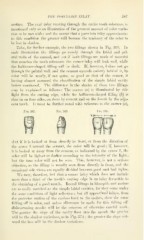Page 389 - My FlipBook
P. 389
;
THE PORCELAIN IXLAY. 387
surface. The oval inlay running through the entire tooth substance is
mentioned only as an illustration of the greatest amount of color varia-
tion to be met with ; and the nearer that a porcelain inlay approximates
to this condition the greater will become the tendency of the color to
be lost in shadow.
Take, for further example, the two fillings shown in Fig. 369. In
each illustration the fillings go evenly through the labial and pal-
atal walls of the enamel, and yet if both fillings are made of material
that matches the tooth substance the corner inlay will look well, while
the halfmoon-shaped filling will be dark. If, however, h docs not go
through the palatal wall and the cement extends entirely behind it, its
color will be nearly, if not quite, as good as that of the corner, it
having almost assumed the classification of the simple labial cavity
before mentioned. The diiference in the shades of these two fillings
may be explained as follows : The corner (a) is illuminated by side
light from the cutting edge, Avhile the halfmoon-shaped filling (6) is
shut in on four sides, on three by cement and on the fourth by the adja-
cent tooth. It must be further noted with reference to the corner (a).
Fig. 367. Fig. 36S
that if it is looked at from directly in front, or from the direction of
the arrow X toward the cement, the color will be good ; if, however,
it is looked at away from the cement, as indicated by the arrow Y, the
color will be lighter or darker according to the intensity of the light
but the true color will not be seen. This, however, is not a serious
obiection, as the filling is usually seen from directly in front, and the
occasional side views are equally divided between good and bad lights.
We may, therefore, feel that a corner inlay which does not include
more than a third of the tooth's cutting edge is an inlay fiivorable to
the obtaining of a good match. Buccal fillings in bicuspids and molars
are as easily matched as the simple labial cavities, for they come under
the same conditions of light reflection ; but all approximal inlays, from
the posterior surface of the canines back to the molars, show the same
falling off in color, and unless allowance be made for this falling off
disheartening results will be the outcome of otherwise careful work.
The greater the slope of the cavity floor into the month the greater
will be the shadow variations, as in Fig. 374 ; the greater the slope out-
ward the less will be the shadow variations.
THE PORCELAIN IXLAY. 387
surface. The oval inlay running through the entire tooth substance is
mentioned only as an illustration of the greatest amount of color varia-
tion to be met with ; and the nearer that a porcelain inlay approximates
to this condition the greater will become the tendency of the color to
be lost in shadow.
Take, for further example, the two fillings shown in Fig. 369. In
each illustration the fillings go evenly through the labial and pal-
atal walls of the enamel, and yet if both fillings are made of material
that matches the tooth substance the corner inlay will look well, while
the halfmoon-shaped filling will be dark. If, however, h docs not go
through the palatal wall and the cement extends entirely behind it, its
color will be nearly, if not quite, as good as that of the corner, it
having almost assumed the classification of the simple labial cavity
before mentioned. The diiference in the shades of these two fillings
may be explained as follows : The corner (a) is illuminated by side
light from the cutting edge, Avhile the halfmoon-shaped filling (6) is
shut in on four sides, on three by cement and on the fourth by the adja-
cent tooth. It must be further noted with reference to the corner (a).
Fig. 367. Fig. 36S
that if it is looked at from directly in front, or from the direction of
the arrow X toward the cement, the color will be good ; if, however,
it is looked at away from the cement, as indicated by the arrow Y, the
color will be lighter or darker according to the intensity of the light
but the true color will not be seen. This, however, is not a serious
obiection, as the filling is usually seen from directly in front, and the
occasional side views are equally divided between good and bad lights.
We may, therefore, feel that a corner inlay which does not include
more than a third of the tooth's cutting edge is an inlay fiivorable to
the obtaining of a good match. Buccal fillings in bicuspids and molars
are as easily matched as the simple labial cavities, for they come under
the same conditions of light reflection ; but all approximal inlays, from
the posterior surface of the canines back to the molars, show the same
falling off in color, and unless allowance be made for this falling off
disheartening results will be the outcome of otherwise careful work.
The greater the slope of the cavity floor into the month the greater
will be the shadow variations, as in Fig. 374 ; the greater the slope out-
ward the less will be the shadow variations.


